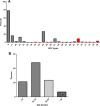Investigation of frequency and typing of human papillomavirus among genital warts using a reverse dot blot hybridization approach
- PMID: 35317740
- PMCID: PMC8941769
- DOI: 10.1186/s12879-022-07276-8
Investigation of frequency and typing of human papillomavirus among genital warts using a reverse dot blot hybridization approach
Abstract
Background: Human papillomavirus (HPV) is the most common sexually transmitted infection worldwide, affecting about 80% of women up to the age of 50. The persistent infection of high risk-HPV types (HR-HPV) is the leading cause of cervical cancer, the fourth most common cancer of women. Therefore, we aimed to evaluate the frequency and typing of HPV in the genital lesions in the Iranian population.
Methods: This descriptive-analytic study was conducted on a population in the South-Khorasan province of Iran. All of the participants were sexually active and were checked for evident cervical warts. Biopsy samples were collected from various lesions, and all samples were tested for detection and genotyping of HPV using a reverse dot blot hybridization method (HPV direct flow CHIP).
Results: In overall, 370 samples were evaluated; 10 cases (2.7%) were male and the rest were female. The mean age of patients was 33.3 ± 8.5 years, of which 48.1% were in the age range from 25 to 36 years. Among the samples, 345 (93.2%) were positive for HPV-DNA; the low risk HPV types (LR-HPV) and HR-HPV were identified among 80.9% and 15.5% of tissue samples, respectively. Among the LR-HPV, HPV-6, 11, 42 and 54 were the most common genotypes, and HPV-16 and 39 were prevalent HR-HPV types detected. The number of pregnancies, marriage age, and partner infection were not significantly related to the HPV types. Types 42 had a declining pattern toward aging, and HPV-11 was increasing toward aging.
Conclusion: The number of samples with HR-HPV was rather high. Due to the greater frequency of infection in the age range of 25-35 years, it is advised that all individuals referred to gynecological clinics at gestational age be tested for HPV types.
Keywords: Cervical cancer; Genotype; HPV; High risk; Iran; Low risk; South Khorasan; Wart.
© 2022. The Author(s).
Conflict of interest statement
All authors of the manuscript have stated to have no conflict of interest for publication of this manuscript.
Figures



Similar articles
-
Spectrum of genital human papillomavirus infection in a female adolescent population.Sex Transm Dis. 1995 Jul-Aug;22(4):236-43. doi: 10.1097/00007435-199507000-00007. Sex Transm Dis. 1995. PMID: 7482107
-
Human papillomavirus genotype distribution in genital warts among women in Harare-Zimbabwe.J Obstet Gynaecol. 2020 Aug;40(6):830-836. doi: 10.1080/01443615.2019.1673710. Epub 2019 Dec 2. J Obstet Gynaecol. 2020. PMID: 31790323
-
The interaction of high and low-risk human papillomavirus genotypes increases the risk of developing genital warts: A population-based cohort study.J Cell Biochem. 2019 Aug;120(8):12870-12874. doi: 10.1002/jcb.28557. Epub 2019 Mar 13. J Cell Biochem. 2019. PMID: 30868650
-
Epidemiology and natural history of human papillomavirus infections in the female genital tract.Infect Dis Obstet Gynecol. 2006;2006 Suppl:40470. doi: 10.1155/IDOG/2006/40470. Infect Dis Obstet Gynecol. 2006. PMID: 16967912 Free PMC article. Review.
-
Epidemiology of genital human papillomavirus infection.Am J Med. 1997 May 5;102(5A):3-8. doi: 10.1016/s0002-9343(97)00177-0. Am J Med. 1997. PMID: 9217656 Review.
Cited by
-
Evaluation of HPV infection and presence of licensed HPV vaccine genotypes among genital warts in Foshan, China.Front Microbiol. 2024 Apr 17;15:1376141. doi: 10.3389/fmicb.2024.1376141. eCollection 2024. Front Microbiol. 2024. PMID: 38699478 Free PMC article.
-
HPV prevalence and genotype distribution among women in eastern China during the Covid-19 pandemic.Hum Vaccin Immunother. 2023 Dec 31;19(1):2212571. doi: 10.1080/21645515.2023.2212571. Epub 2023 May 25. Hum Vaccin Immunother. 2023. PMID: 37226673 Free PMC article.
References
-
- Modesitt SC, van Nagell Jr JR. The impact of obesity on the incidence and treatment of gynecologic cancers: a review. Obstet Gynecol Surv. 2005;60(10):683–692. - PubMed
MeSH terms
Substances
LinkOut - more resources
Full Text Sources
Medical

